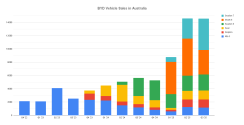Lethe
Captain
Once the September figures come out, I can do a chart showing the model breakdown on a quarterly basis through Q3 '25.

The good news is that BYD is flying in Australia, finishing September as the strongest Chinese brand at #6 with 5084 sales, up 178% YoY, ahead of GWM at #7 with 4945 sales, up 30% YoY. The bad news is that further growth is likely to be more challenging and a slower burn, given that the major volume segments are now covered. Atto 2 is coming to bolster the somewhat underperforming small vehicle segment, but it doesn't help that Denza B5 and B8 are going to come in under that separate brand.
With similar overall volumes between Q2 and Q3, it's easy to identify that the major change is the relative decline of Shark 6 offset by increased Sealion 7 sales. Shark 6 is still selling >1000 vehicles per month and is still neck-and-neck with new Mitsubishi Triton as the 4th best-selling ute in the country YTD, so it is by no means failing. The local sales target for Shark 6 was 10,000 vehicles in this first year, and they are currently at 14,000 YTD.
Interesting contrast can be drawn with the other major ute to debut this year, Kia's Tasman, which is undoubtedly underperforming the company's expectations, recording only 2500 sales in its first three months on sale. Tasman is rather polarizing aesthetically, but it also apparently checks all the boxes in terms of what is expected of a modern ute in the segment, and is coming from a brand that has built up a strong position in the Australian market over decades, including extensive dealer support network and strong warranty coverage. So while part of the lesson is undoubtedly "don't make it so ugly next time", I think there is a deeper truth that, although Australia has a large market for dual-cab utes, it is also a mature market, such that putting yet another well-engineered dual-cab turbo-diesel ute out there doesn't really move the needle. Most Chinese entrants to date have tried to compete on price alone and that is a valid strategy albeit one with a fairly low ceiling. BYD Shark 6 makes waves owing to its unique powertrain characteristics (and corresponding capabilities and limitations) coupled with strong technology integration and interior presentation at mainstream pricepoints. Kia Tasman may be a worthy alternative on fundamentals to the incumbent ICE utes (Ranger, HiLux, D-Max, Triton, etc.) but ... those vehicles already exist, with their largely satisfied customer bases. Of course Nissan is in trouble (new Navara shares platform with Triton) and Isuzu may struggle with fleet-wide NVES emissions penalties as they ramp up, but relying on the competition to fall flat on their face is not a reliable strategy. Beyond powertrain innovations, what we currently lack here are smaller and/or lifestyle utes (despite the fact that domestically produced, sedan-based Holden Commodore and Ford Falcon utes actually constituted most of the ute market here in previous decades) such as Ford Maverick, Toyota HiLux Champ or Hyundai Santa Cruz.
Last edited:
